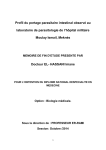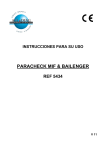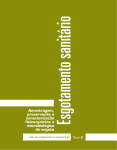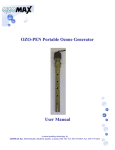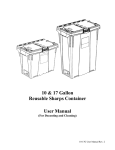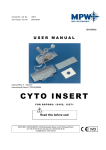Download User manual ParasiTrap - System User manual ParasiTrap
Transcript
User manual ParasiTrap® - System 1 The stool samples are taken by using the plunger of the processing tube I, which is attached to the screw cap. A small sample spoon or a one-way pipette for liquid stool may serve as auxiliary means. The tightly closed tube is shortly shaken once to twice (picture 1). 2 The screw cap of the processing tube I is opened. If necessary, the stool suspension can be stirred with the plunger without using any additional aids: you lift the screw cap approx. 10-15 mm above the brim of the tube and insert it quickly again until it touches the brim of the tube (picture 2). It is important not to lift the plunger above the surface of the fluid! 3 The screw cap of the processing tube I and the empty plunger is removed. Add 1,5 ml Combi Medium carefully to the sample solution (picture 3). 4 Screw the processing tube II with the integrated filter system firmly onto the properly loaded processing tube I from above. Now the assembled system is rotated 180° to allow the sample transfer through the attached filter into the processing tube II (picture 4). 5 180° Mixed by shaker at maximum rotary speed for approx. 10-15 sec. It is enough to slightly press the upper tube with fingertips and simultaneously hold the system. After this operation already half of the stool suspension will be collected in the lower cone-shaped processing tube II (picture 5). If no shaker is available, the system is shaken thoroughly by hand for approx. 30 sec. 6 The part which remains in the upper vessel, is transferred into the lower tube by shaking in vertical direction - like shaking the old clinical thermometer. During the whole shaking process active filtration occurs, which further enhances the yield of parasites. This device is designed in a way, which provides an ideal relation between suspension volume precipitation rate. The suspension is left as it is for 1-2 min. The filtered suspension is centrifuged for 5 min. at max. 1500 g (picture 6, processing by small size centrifuge see below). Instead of centrifuge, leave the system few hours, until the phases have clearly separated. After centrifugation four layers have been formed in the processing tube II. The processing tube I including the filter-piece is removed (picture 7). 1 7 8 The top layer which is solid, has to be detached from the tube´s wall by a cotton wool stick. The processing tube II is carefully decanted. Let it drain well. Do not shake in order to avoid loss of the parasite concentrate (picture 8). 9 Resuspend the parasite concentrate according to demand with 0,05-0,5 ml physiological saline solution or Medium A (AF/SAF/ECO/Bailenger) by repeated aspiration, using the one-way pipette. If the concentrate sediment is sticky, it should be diluted using more solution in order to obtain enough transparency for the microscopical examination (picture 9). For more intensive staining of the concentrated parasites please use high diluted (1:10) Medium C. 10 For diagnosis usually 1-2 drops of concentrated stool suspension dilution per slide will be sufficient. We recommend to read minimum 2 slides for an optimal diagnostics. The cover-glass preparation is now ready for the microscopic diagnostics. Make sure, that your preparation is not too thick (picture 10). You must be able to read a newspaper text through your preparation clearly.* * See also “Important hints for the optimal utilisation of the ParasiTrap® diagnostic system” from Biosepar. Quality control and storage Processing by small size centrifuge Close with cap against desiccation Please use the additional screw cap instead of connected system with tube I and filter-piece. Further processing steps as above 6-10. Copyright by Biosepar GmbH. Reprint prohibited, except by written permission. For later quality control or storage of the concentrated parasites please use the additional screw cap for processing tube II. Please screw the cap firmly to avoid desiccation. 2 Version: 01


